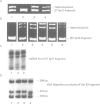Abstract
Type X collagen is a homotrimer of alpha 1 (X) chains encoded by the COL10A1 gene. It is synthesised specifically and transiently by hypertrophic chondrocytes at sites of endochondral ossification. Point mutations and deletions in the region of the COL10A1 gene encoding the alpha 1 (X) carboxyl-terminal (NC1) domain have previously been identified in subjects with metaphyseal chondrodysplasia type Schmid (MCDS). To determine whether mutations in other regions of the gene caused MCDS or comparable phenotypes, we used PCR followed by SSCP to analyse the coding and promoter regions of the COL10A1 gene, as well as the intron/exon boundaries of five further subjects with MCDS, one subject with atypical MCDS, and nine subjects with other forms of metaphyseal chondrodysplasia. Using this approach, three of the subjects with MCDS were found to be heterozygous for the deletions 1864delACTT, 1956delT, and 2029delAC in the region of COL10A1 encoding the NC1 domain. These deletions would lead to alterations in the reading frame, premature stop codons, and the translation of truncated protein products. A fourth subject with MCDS was found to be heterozygous for a single base pair transition, T1894C, that would lead to the substitution of the amino acid residue serine at position 600 by proline within the NC1 domain. We did not, however, detect mutations in the coding and non-coding regions of COL10A1 in one subject with MCDS, the subject with atypical MCDS, and in the nine subjects with other forms of metaphyseal chondrodysplasia. We propose that the nature and distribution of mutations within the NC1 domain of COL10A1 causing MCDS argues against the hypothesis that the phenotype arises simply through haploinsufficiency but that an, as yet, unexplained mutation mechanism underlies this phenotype.
Full text
PDF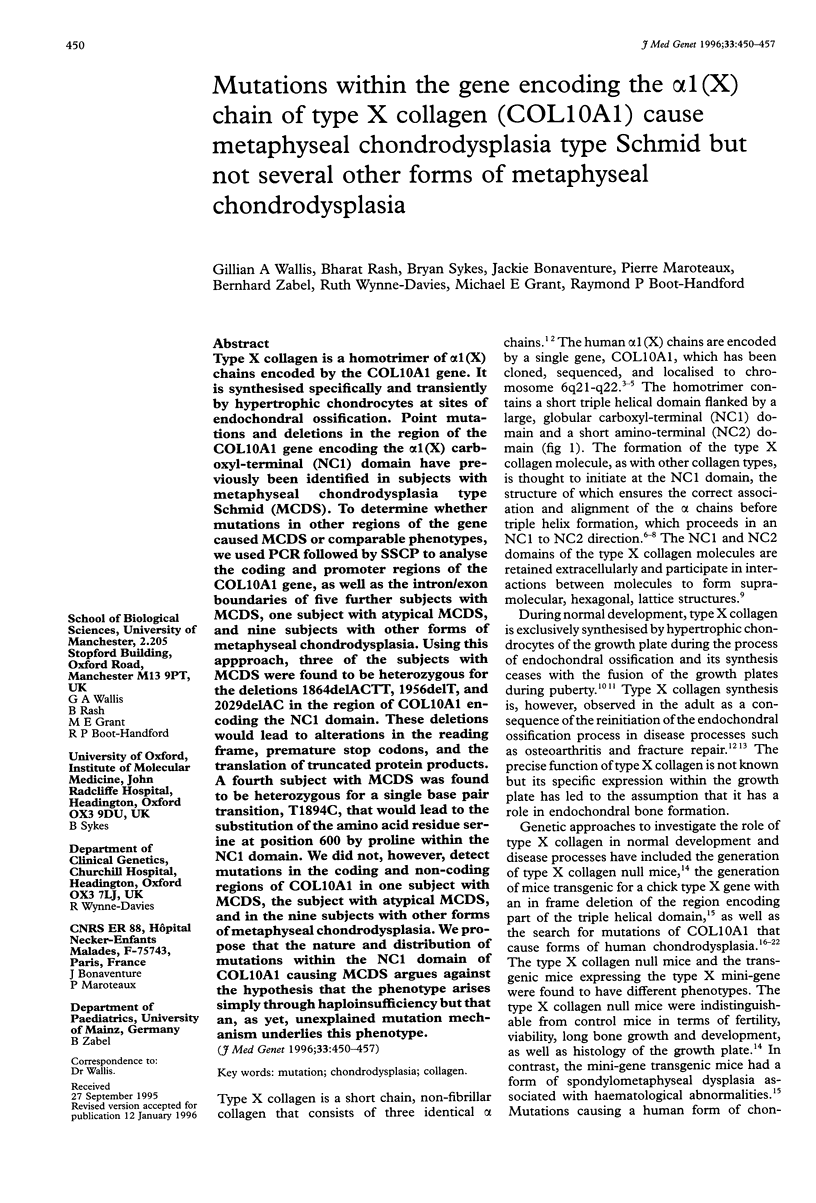
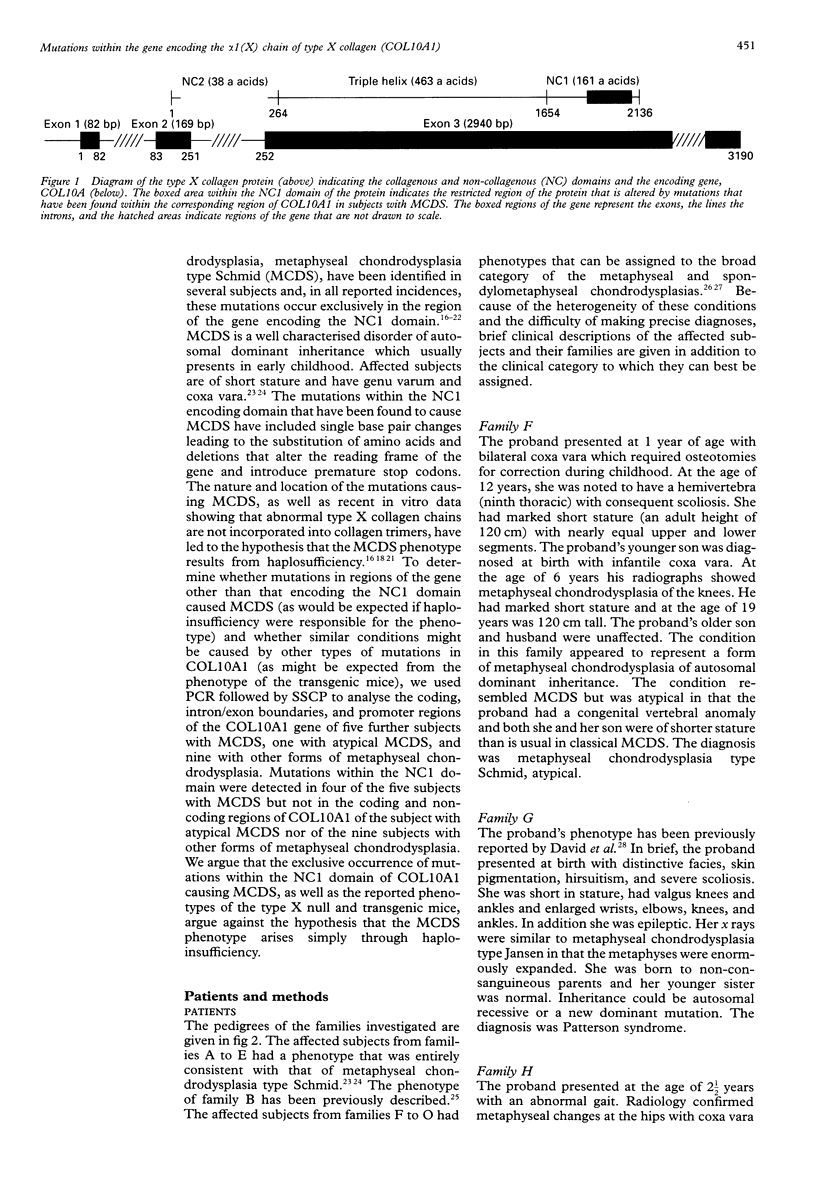
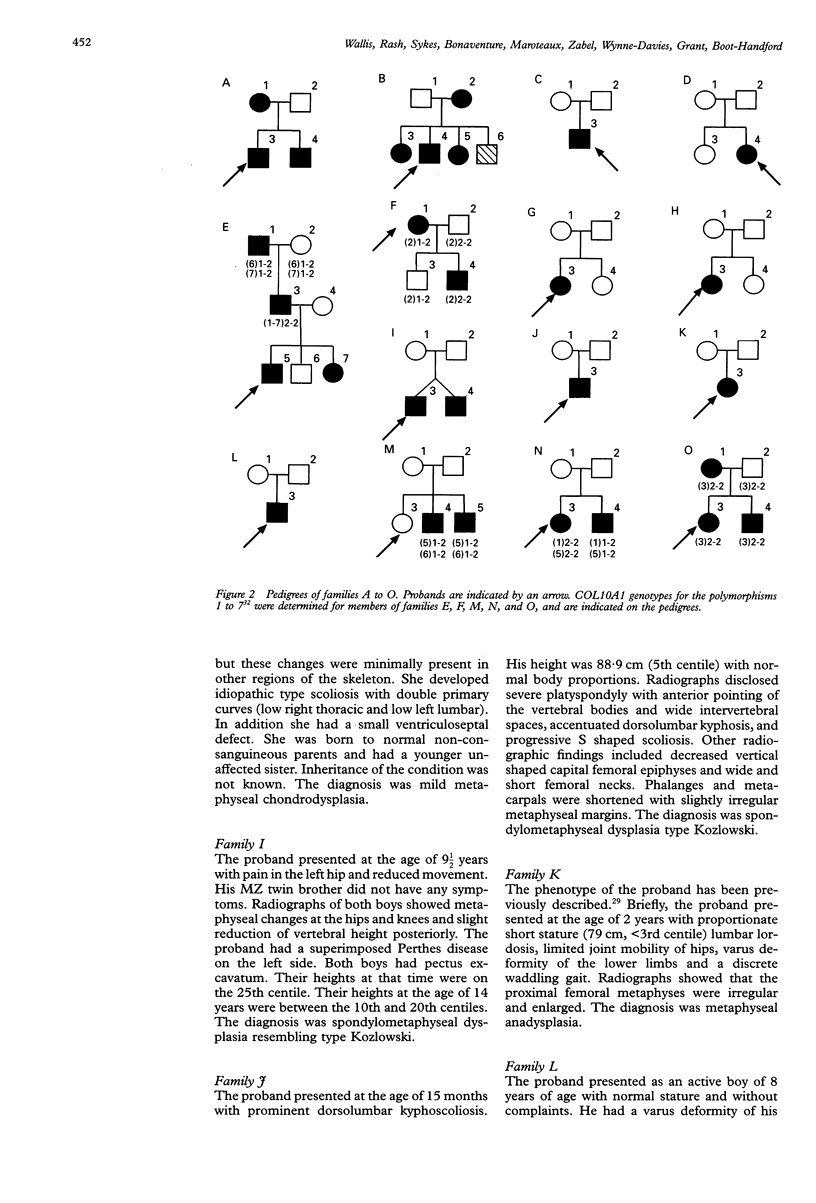
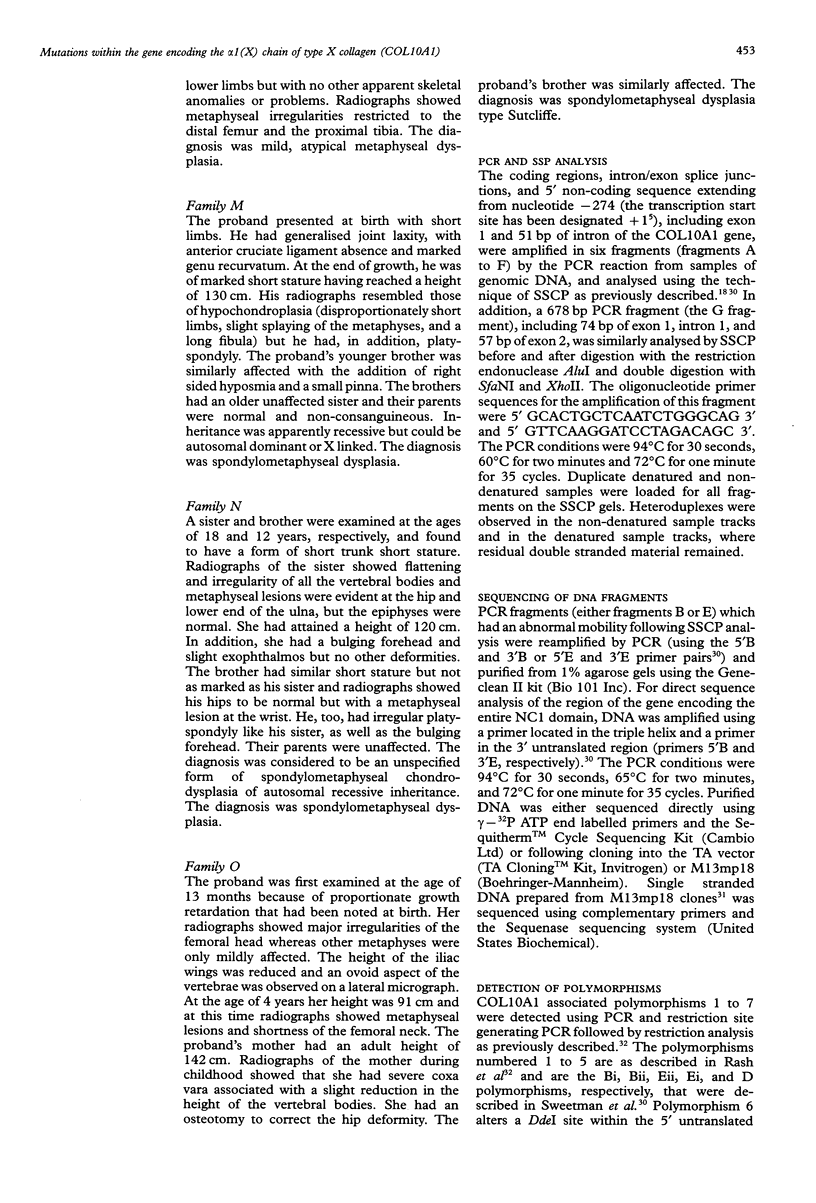
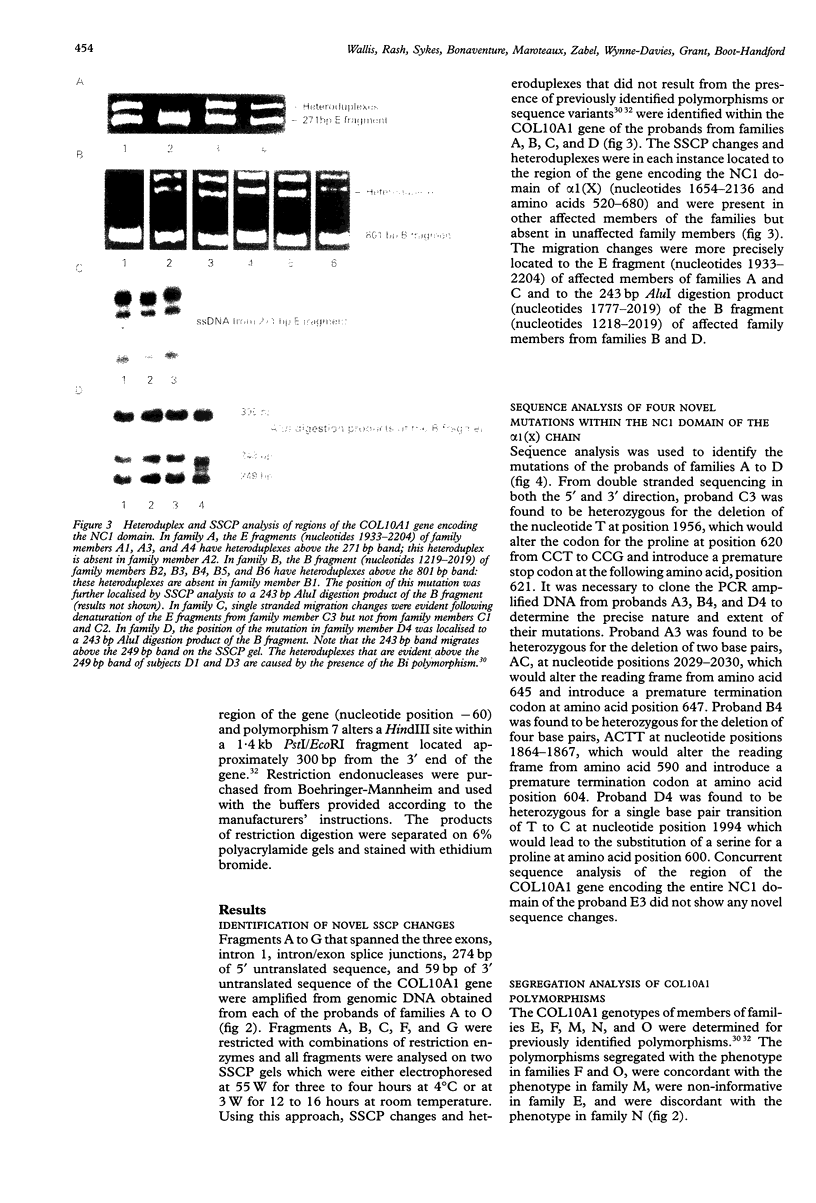
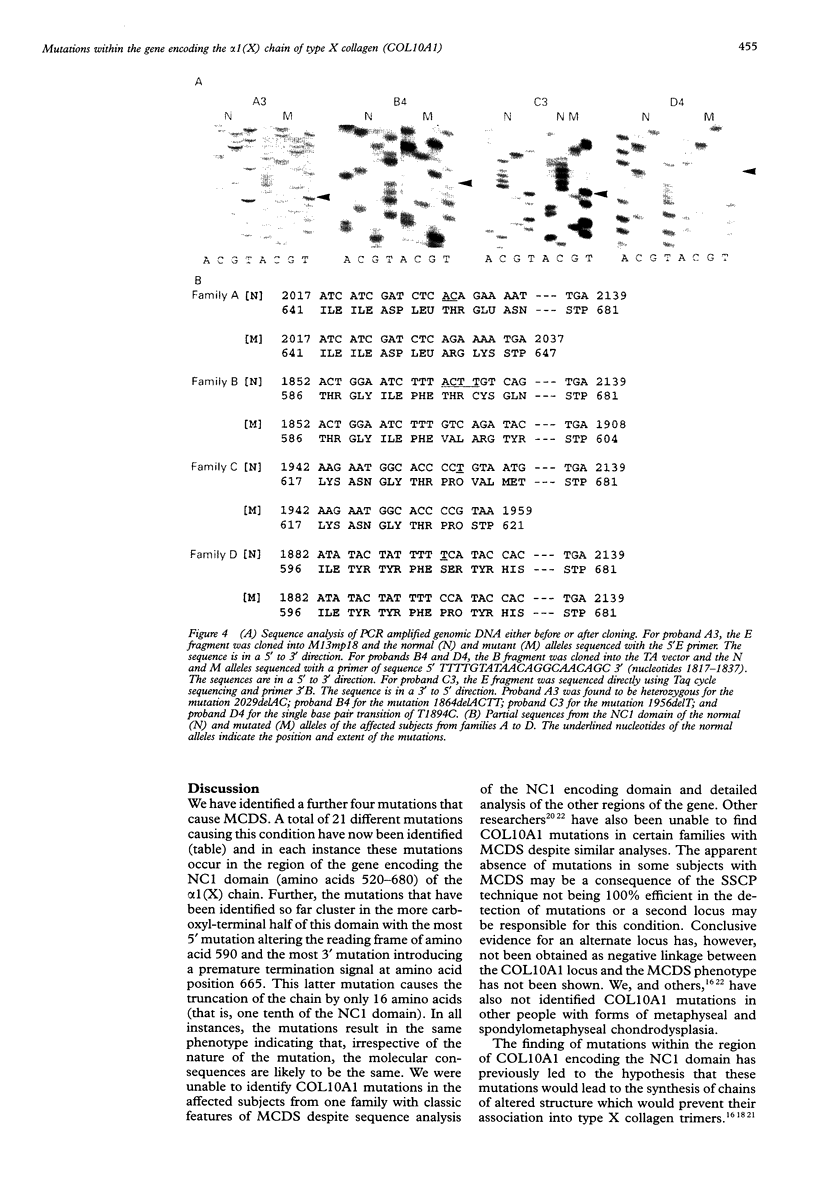
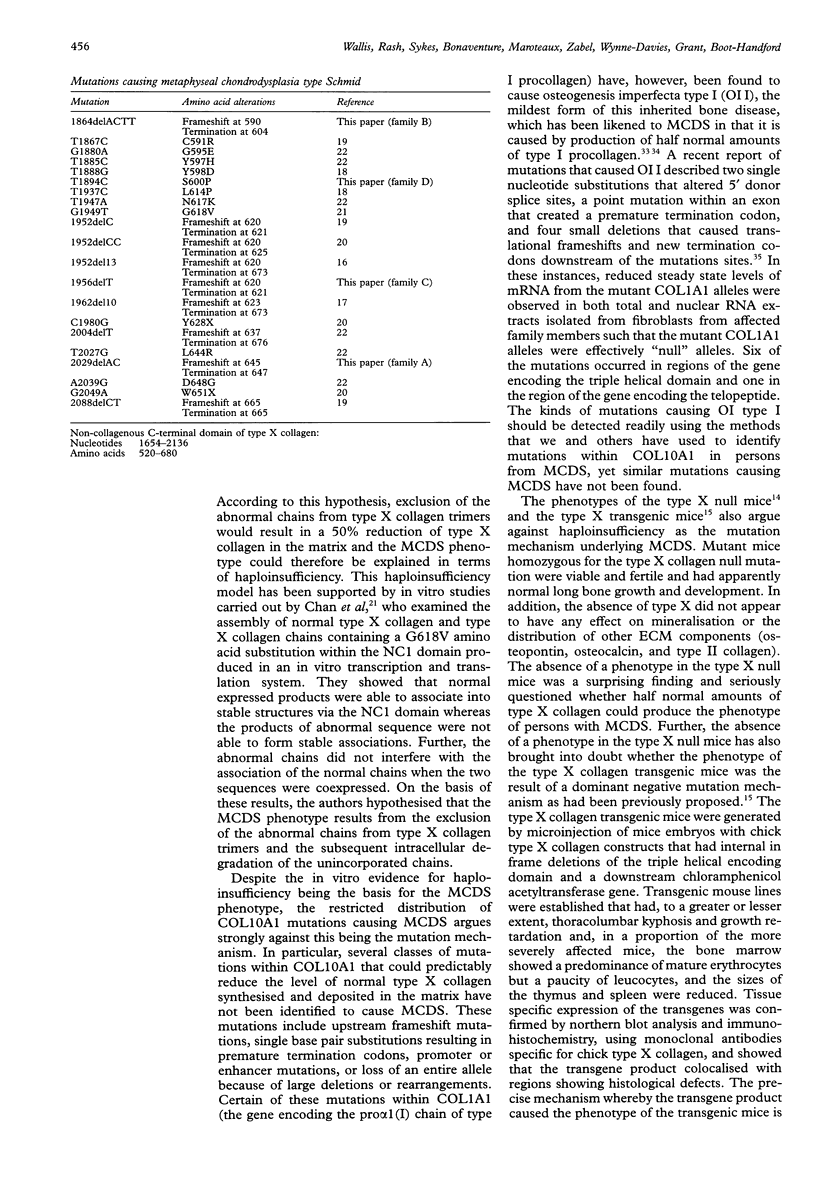
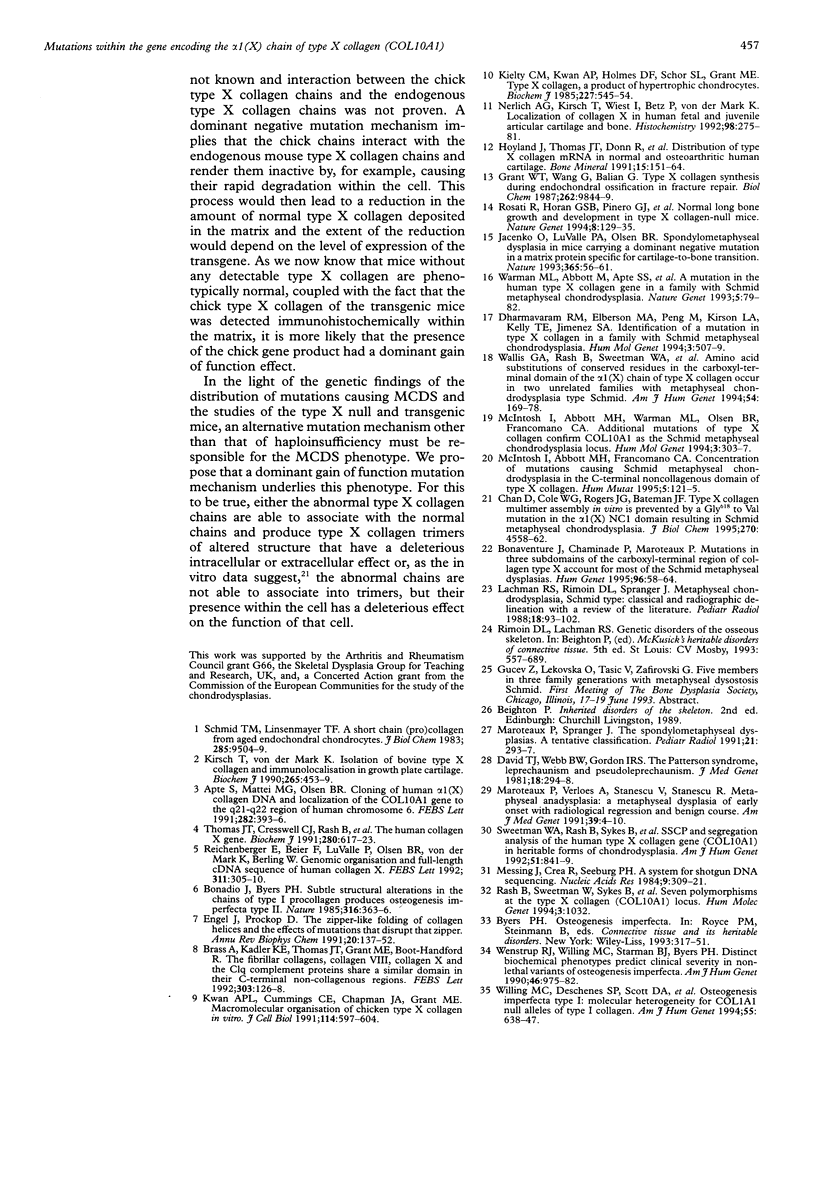
Images in this article
Selected References
These references are in PubMed. This may not be the complete list of references from this article.
- Apte S., Mattei M. G., Olsen B. R. Cloning of human alpha 1(X) collagen DNA and localization of the COL10A1 gene to the q21-q22 region of human chromosome 6. FEBS Lett. 1991 May 6;282(2):393–396. doi: 10.1016/0014-5793(91)80521-4. [DOI] [PubMed] [Google Scholar]
- Bonadio J., Byers P. H. Subtle structural alterations in the chains of type I procollagen produce osteogenesis imperfecta type II. Nature. 1985 Jul 25;316(6026):363–366. doi: 10.1038/316363a0. [DOI] [PubMed] [Google Scholar]
- Bonaventure J., Chaminade F., Maroteaux P. Mutations in three subdomains of the carboxy-terminal region of collagen type X account for most of the Schmid metaphyseal dysplasias. Hum Genet. 1995 Jul;96(1):58–64. doi: 10.1007/BF00214187. [DOI] [PubMed] [Google Scholar]
- Brass A., Kadler K. E., Thomas J. T., Grant M. E., Boot-Handford R. P. The fibrillar collagens, collagen VIII, collagen X and the C1q complement proteins share a similar domain in their C-terminal non-collagenous regions. FEBS Lett. 1992 Jun 1;303(2-3):126–128. doi: 10.1016/0014-5793(92)80503-9. [DOI] [PubMed] [Google Scholar]
- Chan D., Cole W. G., Rogers J. G., Bateman J. F. Type X collagen multimer assembly in vitro is prevented by a Gly618 to Val mutation in the alpha 1(X) NC1 domain resulting in Schmid metaphyseal chondrodysplasia. J Biol Chem. 1995 Mar 3;270(9):4558–4562. doi: 10.1074/jbc.270.9.4558. [DOI] [PubMed] [Google Scholar]
- David T. J., Webb B. W., Gordon I. R. The Patterson syndrome, leprechaunism, and pseudoleprechaunism. J Med Genet. 1981 Aug;18(4):294–298. doi: 10.1136/jmg.18.4.294. [DOI] [PMC free article] [PubMed] [Google Scholar]
- Dharmavaram R. M., Elberson M. A., Peng M., Kirson L. A., Kelley T. E., Jimenez S. A. Identification of a mutation in type X collagen in a family with Schmid metaphyseal chondrodysplasia. Hum Mol Genet. 1994 Mar;3(3):507–509. doi: 10.1093/hmg/3.3.507. [DOI] [PubMed] [Google Scholar]
- Engel J., Prockop D. J. The zipper-like folding of collagen triple helices and the effects of mutations that disrupt the zipper. Annu Rev Biophys Biophys Chem. 1991;20:137–152. doi: 10.1146/annurev.bb.20.060191.001033. [DOI] [PubMed] [Google Scholar]
- Grant W. T., Wang G. J., Balian G. Type X collagen synthesis during endochondral ossification in fracture repair. J Biol Chem. 1987 Jul 15;262(20):9844–9849. [PubMed] [Google Scholar]
- Hoyland J. A., Thomas J. T., Donn R., Marriott A., Ayad S., Boot-Handford R. P., Grant M. E., Freemont A. J. Distribution of type X collagen mRNA in normal and osteoarthritic human cartilage. Bone Miner. 1991 Nov;15(2):151–163. doi: 10.1016/0169-6009(91)90005-k. [DOI] [PubMed] [Google Scholar]
- Jacenko O., LuValle P. A., Olsen B. R. Spondylometaphyseal dysplasia in mice carrying a dominant negative mutation in a matrix protein specific for cartilage-to-bone transition. Nature. 1993 Sep 2;365(6441):56–61. doi: 10.1038/365056a0. [DOI] [PubMed] [Google Scholar]
- Kirsch T., von der Mark K. Isolation of bovine type X collagen and immunolocalization in growth-plate cartilage. Biochem J. 1990 Jan 15;265(2):453–459. doi: 10.1042/bj2650453. [DOI] [PMC free article] [PubMed] [Google Scholar]
- Lachman R. S., Rimoin D. L., Spranger J. Metaphyseal chondrodysplasia, Schmid type. Clinical and radiographic delineation with a review of the literature. Pediatr Radiol. 1988;18(2):93–102. doi: 10.1007/BF02387549. [DOI] [PubMed] [Google Scholar]
- Maroteaux P., Spranger J. The spondylometaphyseal dysplasias. A tentative classification. Pediatr Radiol. 1991;21(4):293–297. doi: 10.1007/BF02018629. [DOI] [PubMed] [Google Scholar]
- Maroteaux P., Verloes A., Stanescu V., Stanescu R. Metaphyseal anadysplasia: a metaphyseal dysplasia of early onset with radiological regression and benign course. Am J Med Genet. 1991 Apr 1;39(1):4–10. doi: 10.1002/ajmg.1320390103. [DOI] [PubMed] [Google Scholar]
- McIntosh I., Abbott M. H., Francomano C. A. Concentration of mutations causing Schmid metaphyseal chondrodysplasia in the C-terminal noncollagenous domain of type X collagen. Hum Mutat. 1995;5(2):121–125. doi: 10.1002/humu.1380050204. [DOI] [PubMed] [Google Scholar]
- McIntosh I., Abbott M. H., Warman M. L., Olsen B. R., Francomano C. A. Additional mutations of type X collagen confirm COL10A1 as the Schmid metaphyseal chondrodysplasia locus. Hum Mol Genet. 1994 Feb;3(2):303–307. doi: 10.1093/hmg/3.2.303. [DOI] [PubMed] [Google Scholar]
- Messing J., Crea R., Seeburg P. H. A system for shotgun DNA sequencing. Nucleic Acids Res. 1981 Jan 24;9(2):309–321. doi: 10.1093/nar/9.2.309. [DOI] [PMC free article] [PubMed] [Google Scholar]
- Nerlich A. G., Kirsch T., Wiest I., Betz P., von der Mark K. Localization of collagen X in human fetal and juvenile articular cartilage and bone. Histochemistry. 1992 Dec;98(5):275–281. doi: 10.1007/BF00270010. [DOI] [PubMed] [Google Scholar]
- Rash B., Sweetman W., Sykes B., Thomas T., Grant M., Boot-Handford R., Wallis G. Seven polymorphisms at the COL10A1 locus. Hum Mol Genet. 1994 Jun;3(6):1032–1032. doi: 10.1093/hmg/3.6.1032. [DOI] [PubMed] [Google Scholar]
- Reichenberger E., Beier F., LuValle P., Olsen B. R., von der Mark K., Bertling W. M. Genomic organization and full-length cDNA sequence of human collagen X. FEBS Lett. 1992 Oct 26;311(3):305–310. doi: 10.1016/0014-5793(92)81126-7. [DOI] [PubMed] [Google Scholar]
- Rosati R., Horan G. S., Pinero G. J., Garofalo S., Keene D. R., Horton W. A., Vuorio E., de Crombrugghe B., Behringer R. R. Normal long bone growth and development in type X collagen-null mice. Nat Genet. 1994 Oct;8(2):129–135. doi: 10.1038/ng1094-129. [DOI] [PubMed] [Google Scholar]
- Schmid T. M., Linsenmayer T. F. A short chain (pro)collagen from aged endochondral chondrocytes. Biochemical characterization. J Biol Chem. 1983 Aug 10;258(15):9504–9509. [PubMed] [Google Scholar]
- Sweetman W. A., Rash B., Sykes B., Beighton P., Hecht J. T., Zabel B., Thomas J. T., Boot-Handford R., Grant M. E., Wallis G. A. SSCP and segregation analysis of the human type X collagen gene (COL10A1) in heritable forms of chondrodysplasia. Am J Hum Genet. 1992 Oct;51(4):841–849. [PMC free article] [PubMed] [Google Scholar]
- Thomas J. T., Cresswell C. J., Rash B., Nicolai H., Jones T., Solomon E., Grant M. E., Boot-Handford R. P. The human collagen X gene. Complete primary translated sequence and chromosomal localization. Biochem J. 1991 Dec 15;280(Pt 3):617–623. doi: 10.1042/bj2800617. [DOI] [PMC free article] [PubMed] [Google Scholar]
- Wallis G. A., Rash B., Sweetman W. A., Thomas J. T., Super M., Evans G., Grant M. E., Boot-Handford R. P. Amino acid substitutions of conserved residues in the carboxyl-terminal domain of the alpha 1(X) chain of type X collagen occur in two unrelated families with metaphyseal chondrodysplasia type Schmid. Am J Hum Genet. 1994 Feb;54(2):169–178. [PMC free article] [PubMed] [Google Scholar]
- Warman M. L., Abbott M., Apte S. S., Hefferon T., McIntosh I., Cohn D. H., Hecht J. T., Olsen B. R., Francomano C. A. A type X collagen mutation causes Schmid metaphyseal chondrodysplasia. Nat Genet. 1993 Sep;5(1):79–82. doi: 10.1038/ng0993-79. [DOI] [PubMed] [Google Scholar]
- Wenstrup R. J., Willing M. C., Starman B. J., Byers P. H. Distinct biochemical phenotypes predict clinical severity in nonlethal variants of osteogenesis imperfecta. Am J Hum Genet. 1990 May;46(5):975–982. [PMC free article] [PubMed] [Google Scholar]
- Willing M. C., Deschenes S. P., Scott D. A., Byers P. H., Slayton R. L., Pitts S. H., Arikat H., Roberts E. J. Osteogenesis imperfecta type I: molecular heterogeneity for COL1A1 null alleles of type I collagen. Am J Hum Genet. 1994 Oct;55(4):638–647. [PMC free article] [PubMed] [Google Scholar]



